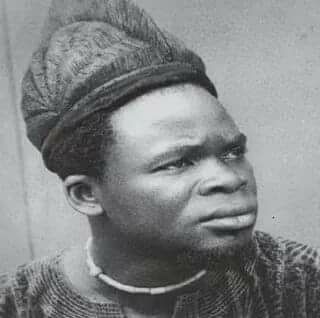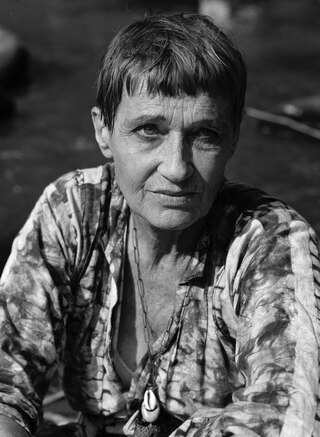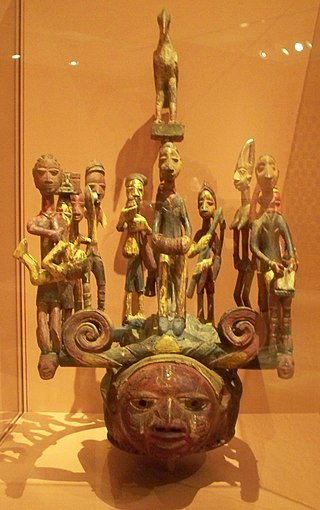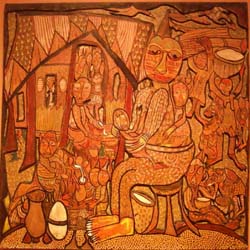
The Gẹlẹdẹ spectacle of the Yoruba is a public display by colorful masks which combines art and ritual dance to amuse, educate and inspire worship. Gelede celebrates “Mothers”, a group that includes female ancestors and deities as well as the elderly women of the community, and the power and spiritual capacity these women have in society. Focusing not only on fertility and motherhood but also on correct social behavior within the Yoruba society.

Durodola Durosomo Duroorike Timothy Adisa Ladipo, more commonly known as Duro Ladipo, was one of the best known and critically acclaimed Yoruba dramatists who emerged from postcolonial Africa. Writing solely in the Yoruba language, he captivated the symbolic spirit of Yoruba mythologies in his plays, which were later adapted to other media such as photography, television and cinema. His most famous play, Ọba kò so, a dramatization of the traditional Yoruba story of how Ṣango became the Orisha of Thunder, received international acclaim at the first Commonwealth Arts Festival in 1965 and on a Europe an tour, where a Berlin critic, Ulli Beier, compared Ladipọ to Karajan. Ladipo usually acted in his own plays.

Chief Nike Davies-Okundaye, also known as Nike Okundaye, Nike Twins Seven Seven and Nike Olaniyi, is a Nigerian batik and adire textile designer. She is best known as an artist for her cloth work and embroidery pieces.
Chief Horst Ulrich Beier, commonly known as Ulli Beier, was a German editor, writer and scholar who had a pioneering role in developing literature, drama and poetry in Nigeria, as well as literature, drama and poetry in Papua New Guinea.

Twins Seven Seven, born Omoba Taiwo Olaniyi Oyewale-Toyeje Oyelale Osuntoki was a Nigerian painter, sculptor and musician. He was an itinerant singer and dancer before he began his career as an artist, first attending in 1964 an Mbari Mbayo workshop conducted by Ulli Beier and Georgina Beier in Osogbo. Twins Seven Seven went on to become one of the best known artists of the Osogbo School.
Elijah Kolawole Ogunmola was a Nigerian dramatist, actor, mime, director, and playwright. Ogunmola is also regarded as one of the most brilliant actors in Africa in the 1950s and ’60s.
Distinctive cultural norms prevail in Yorubaland and among the Yoruba people.
Gerald Clarke is a sculptor, installation, and conceptual artist from the Cahuilla Band of Mission Indians. His work often reflects on and questions current issues in Native America and the United States, as well as his personal life.

An Epa mask is a ceremonial mask worn by the Yoruba people of Nigeria during the Epa masquerade. Carvings representing priests, hunters, farmers, kings, and mothers are usually depicted on the masks. They are used to acknowledge important roles within the community, and to honor those who perform the roles, as well as ancestors who performed those roles in the past.
Trinidad Orisha, also known as Orisha religion and Shango, is a syncretic religion in Trinidad and Tobago and the Caribbean, originally from West Africa. Trinidad Orisha incorporates elements of Spiritual Baptism, and the closeness between Orisha and Spiritual Baptism has led to use of the term "Shango Baptist" to refer to members of either or both religions. Anthropologist James Houk described Trinidad Orisha as an "Afro-American religious complex", incorporating elements mainly of traditional African religion and Yoruba and incorporates some elements of Christianity, Hinduism, Islam, Buddhism, Judaism, Baháʼí, and Amerindian mythologies.
Bakare Gbadamosi is a Yoruba poet, anthropologist and short story writer from Nigeria.

Susanne Wenger MFR, also known as Adunni Olorisha, was an Austrian-Nigerian artist and Yoruba priestess who expatriated to Nigeria. Her main focus was the Yoruba culture and she was successful in building an artist cooperative in Osogbo. She partnered with local artists in Osogbo to redevelop and redecorate the Osun Osogbo Sacred Grove with sculptures and carvings depicting the various activities of the Orishas.

An Oba's crown represents the highest level of authority vested in Yoruba rulers. Referred to as an Ade, the bead-embroidered crown is the foremost attribute of the ruler. An oba's crown may also be referred to as an Adenla, or great crown. Andenla are elaborate conical headdresses, like the ade, but feature a heavily beaded veil that covers the face. In his article on the topic, Robert F. Thompson writes, "The crown incarnates the intuition of royal ancestral force, the revelation of great moral insight in the person of the king, and the glitter of aesthetic experience."

This Magbo helmet mask for an Oro society member was created by Yoruba artist Onabanjo of Itu Meko. It is currently located in the African collection of the Indianapolis Museum of Art, which is in Indianapolis, Indiana. Created around 1880-1910, it depicts a varied cast of community members carved of wood, colored with pigment, and mounted on a curved bar surmounting the helmet.
This wooden female ancestor figure by an unknown Senufo artisan is part of the African collection of the Indianapolis Museum of Art, which is in Indianapolis, Indiana. Carved in the first half of the 20th century, it displays the artist's skill with form and respect for the powerful female half of the primordial couple.
The Mbari Club was a centre for cultural activity by African writers, artists and musicians that was founded in Ibadan, Nigeria, in 1961 by Ulli Beier, with the involvement of a group of young writers including Wole Soyinka and Chinua Achebe. Mbari, an Igbo concept related to "creation", was suggested as the name by Achebe. Among other Mbari members were Christopher Okigbo, J. P. Clark and South African writer Ezekiel Mphahlele, Frances Ademola, Demas Nwoko, Mabel Segun, Uche Okeke, Arthur Nortje and Bruce Onobrakpeya.
Lois Fernandez was a political and cultural activist, best known for founding the Odunde Festival in Philadelphia, Pennsylvania. The festival celebrates African and African-American heritage. It has continued for more than forty years, expanding from one block long to a dozen, and drawing as many as 500,000 people to South Philadelphia.
Ifáyẹmi Ọ̀ṣúndàgbonù Elebuibon is a Yoruba and Nigerian writer, poet, author, linguist, and a world-famous Ifa priest. His plays and films have received worldwide acclamation for his pursuit of the preservation of Yoruba culture and heritage. He also serves as a traveling lecturer in several institutions including at the department of African language and literature at the Obafemi Awolowo University and Black Studies at the San Francisco State University and at the Wajumbe Cultural Institution in California.
Asiru Olatunde (1918–1993) was a Nigerian artist, blacksmith, and painter, often regarded as one of the prominent painters from Osogbo. He was one of a small group of artists who were part of a creative community known as the Oshogbo School of art. His illustrations were centered around Yoruba mythology as well as Biblical stories, combined with local folklore
Chief Muraina Oyelami is a Nigerian painter and drummer of Yoruba descent. He was among the first generation of artists to come out of the Osogbo School of Art in the 1960s. He was a drummer and actor with the theatre company of Duro Ladipo. He taught traditional music and dance at Obafemi Awolowo University from 1976 to 1987. As a musician, he trained in the dùndún and the Batá drum. He was the chief of his hometown Iragbiji.
Twins was not trained by German artists in Oshogbo. He sometimes worked in the house of Ulli Beier and Susanne Wenger and was influenced by this experience. He then worked in association with Georgina Beier and her studio of artists in Oshogbo. There were no Germans involved. Doig Simmonds ex curator African Studies Ibadan 1950 - 1960








